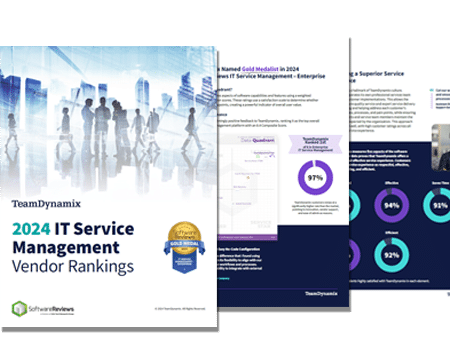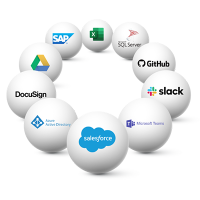
Gainesville Regional Utilities Improves IT Service with Advanced Automation and Integration
Gainesville Regional Utilities (GRU), a multi-service utility owned by the City of Gainesville, uses TeamDynamix for ITSM and iPaaS.

The Info-Tech ranking report offers a unique view of the market based entirely on in-depth customer interviews. Download the Info-Tech ITSM Quadrant and Customer Viewpoint report today.

We’ll show you some of our best situations and show you exactly how to execute them to get immediate results. The best part is, iPaaS tools often feature easy-to-use click and drag functionality, meaning you don’t need a dedicated employee building integrations and workflows.

System Integrators, Value Added Resellers, Technology Providers, and Buying Consortiums can benefit from a partnership with TeamDynamix.

The Info-Tech ranking report offers a unique view of the market based entirely on in-depth customer interviews. Download the Info-Tech ITSM Quadrant and Customer Viewpoint report to gain a better understanding of key vendor strengths and emerging market requirements.
Info-Tech Research conducted a discussion with Hector Molina, Director, Central Project Office, ITCS at East Carolina University (ECU). The focus was on the ECU transition to a holistic approach to service management across the campus.
Q: What were you using for service management? What about project portfolio tracking?
Hector: The old tools we had were quite clunky and generated a lot of dissatisfaction from our end users and IT leadership. Pulling reports was especially difficult – at the time only a few people really had the skill set to do this. It was a nightmare from an administrative perspective as well – it took a lot of time and workarounds to get things working at a passable level. We wanted to improve the overall user experience for the university community and enable greater reporting for our technicians within various teams. We couldn’t accomplish either of these goals with our existing solutions, so we started looking elsewhere.
Q: What made you consider TeamDynamix? Why did you ultimately select them as your vendor of choice?
Hector: Initially, we were looking for a dedicated project and portfolio management (PPM) solution and were evaluating a number of vendors, but TeamDynamix wasn’t one of them. We caught wind of another institution in our system using TeamDynamix for projects and saw that it combined project, portfolio, and IT service management into one platform. A demo was provided by TeamDynamix, and we liked what we saw so we stopped the initial bidding process, revised our requirements and reissued the bid with the hopes that a single platform approach would give us an added benefit of viewing all resources in one place.
Finding out that TeamDynamix can do both project, portfolio, and IT service management was a game-changer for us and led us to accelerate the replacement of our IT service management (ITSM) solution. The people who work both tickets and projects don’t want to use multiple systems; they want one solution that works for everything.
There are tools that don’t do half of what TeamDynamix does and are far more expensive. Finding out that TeamDynamix could do both project portfolio and IT service management was a game changer for us.
- Hector Molina, Director, Central Project Office
How We Got There
Q: What was your experience with the implementation process? What went well or didn’t go well?
Hector: TeamDynamix came onsite for a week to talk to us about the implementation and what other higher education institutions were doing. We liked that we were able to leverage their expertise on processes and procedures in the industry. We wanted to know how other institutions were doing things rather than try to figure out how to fit our square peg in a round hole. They were especially helpful in sharing best practices around demand management. They helped to define and shape how we accept project requests and turn them into projects. That was really valuable to us – re-engineering the intake funnel as a result of their experience with other institutions. Overall, the implementation went very well. If you really wanted to, it could be done in a month – that’s how easy it was to configure the tool.
Q: How did you manage the user-side of the transition following the implementation?
Hector: TeamDynamix provided training for 200 people over the course of a few days. The training was very thorough and provided our users with all the information they needed to start using the solution. If your project timeline allows, I would advise a phased roll-out approach to the training. Starting with some basic building blocks and then conducting a second round to go deeper.
Where Are We Now?
Q: What improvements have you seen in your organization since the implementation of TeamDynamix? What impact, if any, has there been on your overall efficiency?
Hector: TeamDynamix has changed the way we do projects; our resources now have all the information they need at their fingertips. The Resource Management module, in particular, has been crucial to us. We’re now able to understand the true allocation of resources and prove to our leadership that we need more people.
Overall, it’s improved our stakeholder relationships. Our leadership is really excited about the fact that resources can self-serve rather than having to send emails to track down information. Our clients like having visibility into the status of projects and being able to see the degree of completeness. The PPM tool was only going to be used within the IT department, but it’s shown so much potential that other departments have started using it.
I’d say that the solution is saving us close to $15,000/year based solely on the improved visibility for the three PMs in our office. It’s saving time for our PMO resources as well. Overall, TeamDynamix was certainly worth it. There are tools that don’t do half of what TDX does and are far more expensive. What’s so great is that they understand their clients; they haven’t priced themselves out of being used in higher education.
Q: Has the new solution offered any strategic benefits to your institution?
Hector: Before this implementation, we hadn’t considered implementing ITIL. The pre-built materials, industry experience, and general deployment process helped us change how we manage services through our catalog and allowed us to re-think how we provide services to our clients. The configuration process actually doubled as a Service Catalog creation process, saving us a lot of time and helping us ensure that we communicated a comprehensive spectrum of services that we could offer to the institution.
Q: What advice would you give to other institutions who are currently considering TeamDynamix?
Hector: Before you go into this, understand what you need from the tool both on the ITSM and PPM side. We learned that it was better to revamp our existing processes rather than try to fit them into the tool. I encourage you to partner with TeamDynamix versus being prescriptive. Allow them to help guide you.
As with any solution you buy, it’s important to prioritize requirements and understand what’s most important to different stakeholders. TeamDynamix is a great all-in-one solution, but you need to be willing to think outside the box and not corner yourself with existing processes.
TeamDynamix was great for facilitating these difficult conversations. We had weekly calls with the team to discuss our issues, and they provided suggestions without trying to force their ideas on us. But if you’re not open to change then the solution won’t work.

Gainesville Regional Utilities (GRU), a multi-service utility owned by the City of Gainesville, uses TeamDynamix for ITSM and iPaaS.

Combining ITSM with automation and integration (iPaaS) on a single, codeless platform is helping NaphCare improve its IT service desk.

CUSTOMER SPOTLIGHT Shaner Hotel Group Levels Up IT Service Management with Improved Self-Service Portal, No Code Workflow and Better Ticket Triage Customer service is the
TeamDynamix’s award-winning SaaS cloud solution offers IT Service and Project Management together on one platform with enterprise integration and automation.
[email protected]
(877) 752-6196
Contact Us
